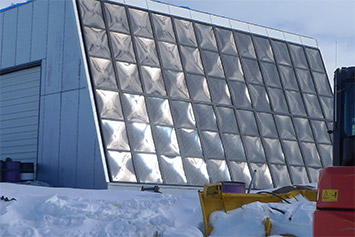National Institute of Polar Research
Polar Engineering Group
Follow-up of supporting technology for polar science observation
Leader Satoshi IMURA
Function of Polar Engineering Group
Our group addresses technical challenges associated with scientific observation and logistic activities. As one could imagine, there are a multitude of technical challenges to overcome when conducting research in the polar region. For example, it is very important to use limited fuel, food and material effectively because the means of transportation is hampered in the polar zone. We must also reduce our impact on the local environment.
Study of logistical problems for future inland operations
To carry out inland operations in the Antarctic, we need to solve several logistical issues, such as transporting large quantities of goods, ensuring safe transport routes, minimizing the physical vibration in transportation of precision equipment, and building and construction on the ice sheet. To address these issues, information collection and test development through the introduction of new policies and technology are essential along with taking advantage of accumulated data and experience.
Investigation for on-site energy production
The fuel consumption at Syowa Station increases yearly due to expansion of the station and scientific observations conducted at the station. As there is a limit on the amount of fuel transportable by ship, it is vital to maintain an ever shrinking fuel reserve at the station. In order to improve this situation, we are working to increase production of renewable energy, such as wind and solar power to reduce our dependency on fossil fuels. As part of the study, investigations like effective array and surface deterioration of PV panels are carried out.

Solar panels for room heating installed on the wall of a building at Syowa Station
Study on interconnected power systems between diesel and renewable energy
Power generated via wind turbines and PV are dependent on wind speed and insolation condition. Since wind speed and insolation conditions fluctuate, technologies of interconnected power systems between diesel and renewable energy are of great interest, and we are exploring solutions suitable for polar regions.
Study on storage and utilization system of surplus power
Currently, surplus power generated through renewable energy systems is often lost. To combat this loss, we are collaborating with university researchers and private companies to develop effective and efficient storage systems. The use of organic hydride is one such method of storing hydrogen and is an appropriate technology for polar regions because the substance is stored as an antifreeze liquid. Heat storage technologies of sustainable energy are close to practical use.
Study on making water
Drinking water at the Syowa Station is sourced from local snowmelt. This method of creating drinking water requires an enormous amount of energy. A less energy hungry system is available: the reverse osmosis membrane method. By utilizing sea water near Syowa Station, energy consumption decreases and the need to cast snow blocks into water tanks is no longer required. Prior to deploying the reverse osmosis method, studies on temperature control of water pipelines and sea water pumping are required. Research in this is currently being conducted.
Development of unmanned observation system
Unmanned operations reduce CO2 emissions and have reduced energy requirements in comparison with manned operation. As previously stated, we strive to reduce our carbon footprint and energy requirements. To that end, we have developed a high reliability robot observation system based on satellite systems. Next, we will introduce the use of unmanned aerial vehicles and small energy generator systems.









